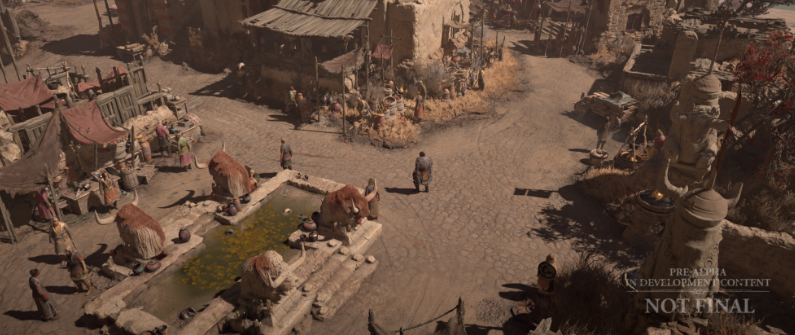Diablo 4 Towns & City
Diablo IV is divided into a number of regions. Each region has a main hub town, along with numerous other towns spread throughout the area. Some strongholds can become towns, once they've been cleared of enemies. Diablo 4 towns may become social hubs for a player once key story elements have been completed. Towns have high population caps, and players will generally see each other here.
For example, Kyovashad is the city of Fractured Peaks. It is a safe zone where you can repair and purchase new gear, upgrade your health potion, access the Stash, and much more. Think of the city as your base of operations between excursions into the frigid expanse of the zone.
Towns D4
Over 100 settlements of various sizes are planned for release; this includes Towns and Strongholds. Major towns are the social hubs of the game, where you will find quests, vendors, a waypoint, and other players. You can inspect other players, trade with them, or look for a group.
Locations in Diablo 4 covers the different places in the open world that the players can explore. Diablo 4 allows players to explore the open world of Sanctuary that is divided in 5 different Regions: Scosglen, Dry Steppes, Kehjista, Fractured Peaks, Haweza. Each region provides with a distinctive feel and a variety of Enemies.
Players can also explore and re-play a series of 150 Dungeons scattered across all regions. These Dungeons provide the player with different challenges and monsters and may have a mini-boss at the end. There are also Enemy strongholds that can be reclaimed to be converted into friendly towns and hubs that have potential to unlock Dungeons that may hold valuable rewards. With the open world, there is no linear path to follow, and players are free to explore each location as they please. Each location will also feature unique local events that players can choose to participate in for additional rewards.

Corbach, a town in Scosglen (left) and an unknown town in an arid location (right).
Players will be able to use mounts to traverse across long distances. World Bosses are encountered in the open-world areas. The open-world is fixed, and not randomized. While the game has shared-world elements, it is not an MMO. Towns may become social hubs for a player once key story elements have been completed. Roads link various areas—sticking to the roads allows players to bypass monsters, while heading off the path will take them towards higher monster densities. Each zone has associated renown that the player can earn. The campaign is expected to take 45–50 hours to complete on a first playthrough.
Diablo 4 Gold, Items, Boosting
- Diablo 4 Items for Sale (6% off coupon: vhpg). Fast and Safe Diablo IV Items. 5-star service, nice discount, instant delivery.
- Buy Diablo 4 Gold (5% off coupon: VHPGMULE). Cheap Diablo 4 Gold. Payment: PayPal, Skrill, Cryptocurrencies.
Town Guides
The world is how you engage with other players in Diablo 4. We'll have social hubs in major towns. This is one from our demo: Corbach. In these towns, not only is this where you pick up quests and talk to NPCs, but you can trade, ask someone about their gear, investigate their build, take a look at how they customize their character and what awesome armor they're wearing. You might even be able to look for a group.
Spread across Diablo 4's massive open world, you'll find towns, which Blizzard says are used to:
- Receive and return quests
- Meet other players
- Buy and sell items from vendors
- Learn about the game's lore
List of Diablo 4 Towns
1. Corbach
Corbach is a town in Scosglen, lorded over by Chieftain Nora Corse. It is located in/adjacent to the Loch Raeth Highlands.
Known Inhabitants
- Arrin Corse
- Edan Corse (formerly)
- Nora Corse
- Cullen
- Una the Elder
2. Kyovashad
Region: Fractured Peaks
Architectural elements:
- Cobblestone roads
- Stone towers and walls
- Metal gates
- Lumber structures
- Torches and lanterns
Color palette: Gray, white, and brown
Weather: Frigid and snowy
3. Dry Steppes Towns
Region: Dry Steppes
Inhabitants: Barbarian people
Architectural elements:
- Canopy and domed tents
- Dusty, sandy roads
- Clay brick structures
- Baskets and metal jars
Color palette: Tan, brown, and maroon
Weather: Misty
4. Hawezar Towns
Region: Hawezar
Inhabitants: Witches
Architectural elements:
- Huts made of sticks
- Cauldrons
- Crude wooden paths
- Built atop a swamp
Color palette: Warm browns and blue
Weather: Misty
D4 Guides & Tips
| Items | |
|---|---|
| Skills | |
| Guides |